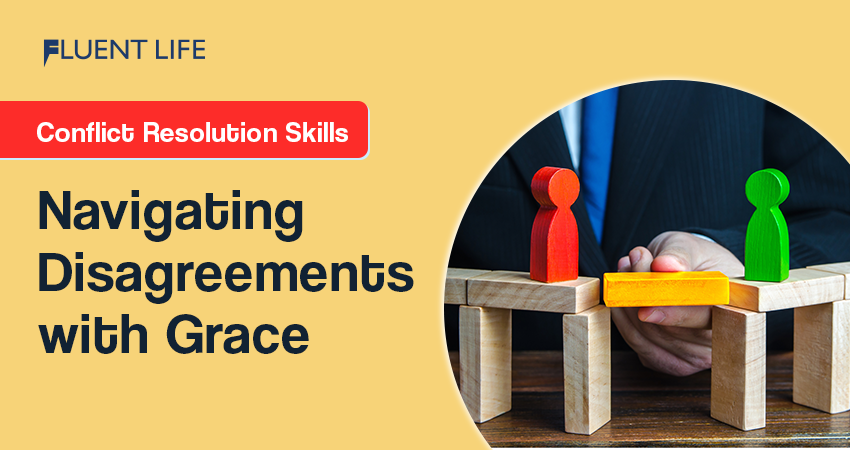Conflicts are part of everyday life. But, how we handle them is the key. To effectively resolve disputes, we must master the art of active listening and communication by mastering the conflict resolution skills. Also, emotional intelligence and empathy go a long way.
When in disagreement, actively listening to the other person’s perspective is vital. This allows us to find common ground and work together on a solution. Additionally, we must remember to stay composed and practice self-awareness. Taking a pause to reflect on our words helps us choose a diplomatic approach.
Besides active listening, empathy is a must. It helps us understand the other person’s feelings and motivations better, and demonstrates genuine care. This creates a sense of trust and opens up opportunities to find a beneficial outcome.
Lastly, compromise is essential. Focusing on areas of agreement rather than trying to “win” an argument encourages collaboration. By considering different perspectives and being open to alternative solutions, both parties feel heard and valued.
Understanding Conflict Resolution Skills
To navigate disagreements with grace, gain a comprehensive understanding of conflict. Define conflict, identify common causes, and recognize the significance of resolving conflicts.
Definition of Conflict
Conflict is a clash or disagreement between two or more parties. It’s a natural part of human interactions, occurring in relationships, work environments, and society. To resolve conflicts, it’s important to be proactive and open communication channels. Listening without judgement is crucial. Focusing on interests rather than positions can help identify common ground. Collaboration encourages creative problem-solving to meet everyone’s needs while maintaining respect.
Common Causes of Conflict
Conflict can arise in many circumstances. Being aware of the causes can help individuals resolve disputes better and stop them from becoming worse. Here are five points to think about:
- Differing values and beliefs: Conflict can occur when people have different values and beliefs. This can lead to clashes in opinions and make it hard to reach an agreement.
- Limited resources: Conflict often occurs when resources, like money, power, or time, are sparse. This can cause tensions and arguments.
- Miscommunication or lack of communication: Problems in communication or misinterpretations can also cause conflict. If people are unclear in expressing themselves or don’t understand each other’s intentions, it can lead to conflict.
- Inequalities in power: Conflict may happen when one person or group is more powerful than the other. This power imbalance can cause people to feel exploited, and conflicts can result.
- Personal differences and different personalities: Conflict can stem from personal differences and clashes in personalities. Backgrounds, characters, and communication styles that are different can cause friction and make conflict resolution tough.
Apart from these typical causes, external factors such as political or social unrest can also lead to tension and fights between individuals or communities.
Take this story as an example: Two families in a small neighborhood were always arguing over access to clean water due to its scarcity. Both thought their need was bigger than the other’s. The clash became worse due to misunderstandings, but when a mediator was brought in, communication improved and both families were able to reach a compromise.
By being aware of the typical causes of conflict and looking at real-life examples, individuals can learn to detect the main reasons behind conflicts and work towards peaceful solutions.
Importance – Conflict Resolution Skills
Conflict resolution is essential. It builds positive relationships, encourages growth and prevents bad outcomes. It also encourages effective communication and collaboration, where everyone’s needs are met.
Acknowledge the importance of open dialogue. Create a safe environment so all parties can express their thoughts and perspectives. Doing this allows for mutual understanding. Listen carefully and communicate respectfully to deescalate the conflict.
Managing emotions effectively is also important. Emotions often shape people’s behaviors and reactions. Having control over your emotions helps you make rational decisions and have positive discussions.
Adopt a problem-solving mindset. Focus on finding practical solutions rather than dwelling on the past. View conflicts as opportunities – this will bring positive outcomes.
Research by the APA shows that unresolved conflict has a negative impact on wellbeing and productivity. So address conflicts proactively to maintain harmony and achieve collective goals.
Also Read: Master the Art of Small Talk: Engaging Conversation Tips
Conflict Resolution Skills
To navigate disagreements with grace in conflict resolution skills, leverage active listening, effective communication, empathy and understanding, collaborative problem solving, and managing emotions. Each sub-section offers valuable solutions to address conflicts professionally and respectfully.
Active Listening
Unlock the potential of active listening! Focus on the speaker, take in their perspective, and show interest through verbal & non-verbal cues. Creating trust & empathy helps us find common ground and solve problems. Avoid interrupting or making assumptions. Use body language to express attentiveness. Utter verbal affirmations like “I understand” or “Tell me more” to show genuine interest. Paraphrase & summarize to demonstrate comprehension & validate feelings. Active listening cultivates a mutual respect, essential for conflict resolution. Don’t miss out on these valuable skills – start today & experience its transformative power!
Effective Communication
Effective communication is vital for resolving conflicts. When we communicate well, we actively listen, express ourselves and seek to understand others. This allows us to handle conflicts with respect and empathy.
In conflict resolution, communication is key. By listening to all involved, we can learn more about the issues. We can also avoid misunderstandings by expressing our thoughts and feelings clearly. By seeking to understand others, we can reach a compromise.
Non-verbal cues, like body language and voice tone, are also important in communication. Taking note of these helps us interpret the meaning behind words and feelings. It also helps us convey our intentions accurately. As such, aligning our verbal and non-verbal communication reduces the chances of miscommunication-related conflicts.
To improve conflict resolution via effective communication, practice active listening. Paraphrase or summarize what the other person has said before responding. Be conscious of your emotions and pay attention to non-verbal cues. Make eye contact and maintain an open body posture.
Empathy and Understanding
Empathy and understanding are must-haves in conflict resolution. Seeing the world from someone else’s eyes leads to a better understanding of their outlook. This helps us respond with empathy – acknowledging their feelings and validating their experiences.
During a quarrel, active, attentive listening is required. This conveys our commitment to grasp the other person’s view. Refrain from interrupting or imposing opinions. Instead, ask open-ended questions to let them express thoughts and emotions.
Body language is also key in displaying empathy. Eye contact and suitable facial expressions show we are engaged and respect what the other has to say. Nodding and reassuring gestures can also demonstrate empathy.
It’s important to remember that empathy doesn’t mean agreement or okaying unacceptable conduct. It means recognizing the feelings behind someone’s words or actions without judgement. We can support their emotions by repeating what they have shared accurately.
Storytime:
A couple had a long-running row about dishwashing. The husband thought it was his wife’s job, since she cooked most meals. The wife, however, felt overwhelmed, having to cook and clean up after dinner every day.
One day, during an intense dispute about dish duties, they decided to practice empathy instead of criticizing each other. The husband acknowledged his wife worked hard too and felt drained after making dinner. He felt her battle and saw why she needed help with washing dishes.
This story shows that empathy let the couple understand each other’s point of view. By imagining themselves in the other’s shoes, they found a compromise where both felt heard and supported.
Collaborative Problem Solving
Collaborative problem solving means working together to discover solutions to complicated issues. This necessitates good communication, attentive listening, and a readiness to comprehend different perspectives. Through uniting unique skills and knowledge, teams can get past difficulties and attain successful results.
The main elements of collaborative problem solving are:
| Elements | Description |
|---|---|
| Communication | Sharing ideas and facts openly and honestly |
| Active Listening | Thoroughly understanding others’ points of view by listening carefully |
| Teamwork | Cooperating efficiently with others to reach a mutual goal |
| Critical Thinking | Examining problems from varied angles to come up with creative solutions |
Collaborative problem solving goes beyond traditional approaches. It emphasizes collective thinking and decision-making. This method promotes creativity and encourages participants to think in a new way. By using the power of collaboration, organizations can take advantage of their members’ strengths and manage complex dilemmas with agility.
In history, many examples demonstrate the potency of collaborative problem solving. For instance, the Apollo 13 mission in 1970. When facing a critical systems breakdown in space, NASA engineers and astronauts worked hard together to develop original solutions using accessible materials. Their focus and teamwork eventually made sure the crew returned to Earth safely.
Collaborative problem solving is a strong tool for dealing with disputes and furthering organizational success. By utilizing this approach, individuals can use their combined knowledge and create lasting solutions that benefit everyone involved.
Managing Emotions
Emotions are key to resolving conflicts. Here are tips to manage them:
- Acknowledge emotions without judging.
- Breathe and think before responding.
- Put yourself in the other’s shoes.
- Use “I” statements to express emotions without blaming.
- Reach out to a friend or professional for help.
Managing emotions is essential for successful conflict resolution. By acknowledging and understanding our emotions and others’, we can create better problem-solving conditions.
Studies show that people with high emotional intelligence handle conflicts better. Daniel Goleman (author of “Emotional Intelligence“) says they understand and regulate their emotions, and also connect with others on an emotional level. This helps resolve conflicts and build relationships.
Emotional intelligence is useful for managing emotions during conflicts. It helps to stay calm and look for mutual solutions. Developing these skills can improve our interpersonal relationships and make a harmonious environment.
Also Read: Conversational Etiquette Tips: Do’s and Don’ts in English
Navigating Disagreements with Grace
To navigate disagreements with grace, maintain respect and civility, find common ground, and seek win-win solutions.
Maintaining Respect and Civility
Respect and civility are key when dealing with disagreements. Open-mindedness, active listening, and empathy are essential. Constructive dialogue leads to understanding, not personal attacks.
When disagreeing, focus on the issue instead of attacking the person. Remain calm to foster healthy discussion. Active listening is crucial – pay attention to the speaker without interrupting. Show empathy and acknowledge their feelings before expressing your own.
Also, look for common ground – shared goals or values can help bridge gaps. This creates a foundation for solutions that both sides can agree on.
Pro Tip: Respect does not mean avoiding disagreements. Diversity of thought should be embraced. Debate, but be kind and considerate.
Finding Common Ground
Discovering shared interests is essential when managing disputes. Creating consensus needs an open-minded attitude and successful communication. Through finding similar values and interests, people can strive for an agreement that satisfies all.
Exploring how to discover common ground, let’s think of a realistic example. Picture a team of workers from different divisions assigned to collaborate on a project. To make sure everyone understands, they can form a table to match their ambitions and objectives.
| Department | Goals | Objectives |
|---|---|---|
| Marketing | Raise brand visibility | Launch specific marketing campaigns |
| Finance | Optimize budget allocation | Put into practice cost-saving measures |
| Operations | Streamline production processes | Enhance supply chain efficiency |
| IT | Improve data security | Upgrade software systems |
Through this table, teams can quickly see where their goals match and spot areas where accommodation may be required. This visual representation encourages openness and encourages conversations.
In addition to setting up a table, it is important to create an atmosphere that encourages attentive listening. Allowing everyone to express their worries without interruption helps build faith and appreciation. This technique encourages empathy and understanding, often leading to imaginative problem-solving.
In practice, I saw the influence of finding common ground personally during a fierce disagreement between two coworkers. Both were definite of their individual thoughts for an upcoming project. Though, by deliberately seeking similarities in their ideas and exploring alternative solutions together, they managed to combine their ideas into a creative strategy that pleased both parties.
Identifying common ground requires time and patience. It needs putting aside personal biases and concentrating on shared objectives for the benefit of all. By handling differences with politeness and an open mind, we can bridge gaps and obtain successful results.
Seeking Win-Win Solutions
For graceful disagreement navigation, win-win solutions that prioritize collaboration and mutual benefits are essential. Common ground helps all feel heard and respected. Strategies to achieve win-win outcomes include:
- A collaborative approach focused on shared goals and values
- Effective communication with active listening, empathy, and clear expression
- Creative problem-solving with innovative solutions
- Compromise with willingness to make concessions without compromising integrity
Moreover, open dialogue provides space for all to express perspectives. Listen deeply to understand one another without judgement. Respect and understanding create a win-win solution.
Win-win solutions not only boost relationships, but also productivity and a positive work culture. Don’t miss the chance for harmony–choose collaboration over confrontation.
Also Read: Top 100 Commonly Used A to Z Phrasal Verbs for English Fluency
Conclusion – Conflict Resolution Skills
Navigating conflicts with grace is a must! It can lead to positive outcomes, both in personal and professional relationships. To do this, it’s essential to approach disagreements with empathy, actively listen to others’ perspectives, and look for solutions that benefit everyone. Acting with integrity and understanding how people feel is also important.
We’ve explored strategies for resolving conflicts. We talked about staying calm and expressing yourself without aggression or defensiveness. We discussed finding common ground and compromising when needed. Plus, we looked at the value of active listening – truly hearing each other’s perspectives and validating feelings.
It’s also important to view conflicts as growth opportunities and seek outside help if needed. Involving a mediator can help facilitate understanding and reach a solution. Conflict resolution is an ongoing process that requires effort and open-mindedness. So, let’s develop our skills and foster harmony. Know More – The Fluent Life
FAQs – Conflict Resolution Skills
Q1: Why are conflict resolution skills important?
A: Conflict resolution skills are important because they help individuals navigate disagreements peacefully and effectively. These skills promote healthy communication, foster understanding, and maintain positive relationships.
Q2: How can I develop conflict resolution skills?
A: Developing conflict resolution skills involves active listening, empathy, and effective communication. It also requires practicing patience, seeking compromise, and being open to constructive feedback.
Q3: What are some common strategies for resolving conflicts?
A: Some common strategies for resolving conflicts include active listening, finding common ground, focusing on interests rather than positions, and brainstorming creative solutions mutually beneficial to all parties involved.
Q4: How can I stay calm during a disagreement?
A: Staying calm during a disagreement can be achieved by taking deep breaths, using positive self-talk, and practicing mindfulness. It’s important to address your emotions constructively and focus on finding a mutually agreeable resolution.
Q5: How do I address conflicts in professional settings?
A: Addressing conflicts in professional settings requires professionalism, respect, and diplomacy. It’s essential to communicate assertively, avoid personal attacks, and work towards finding win-win solutions that benefit everyone involved.
Q6: What should I do if a conflict becomes escalated?
A: If a conflict becomes escalated, it’s important to take a step back, allow for a cooling-off period, and consider seeking the assistance of a neutral third party, such as a mediator or supervisor, who can help facilitate a productive resolution.






